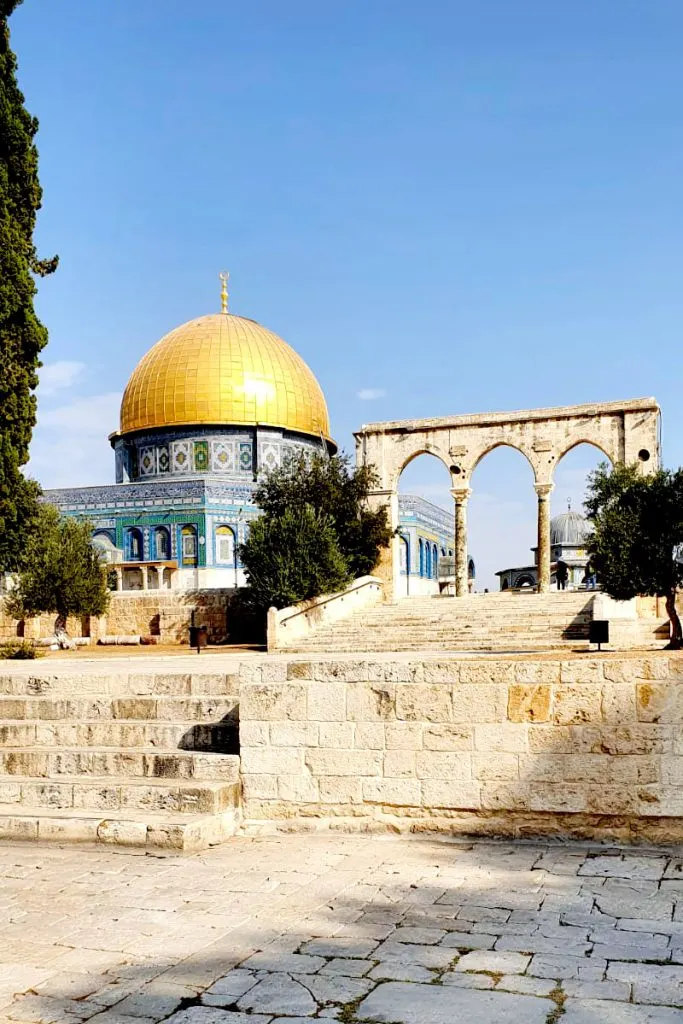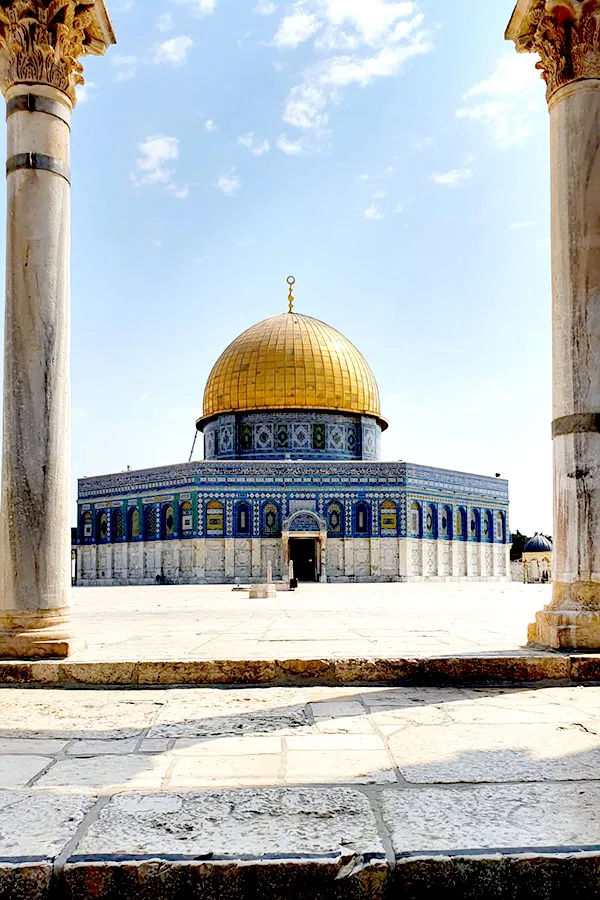The Temple Mount is the holiest site in Judaism and where both Jewish Temples stood in the Old City of Jerusalem.
King Solomon built the First Temple on the Temple Mount over 3000 years ago.
For over 400 years Jewish pilgrims came from all over the country to worship there until the Babylonians pillaged and destroyed the Temple.

The Holy Ark and the Ten Commandments, which were in the Temple, vanished with its destruction.
Then, after Cyrus the Great conquered Babylonia, he permitted the Jews to rebuild the Temple.
The Second Temple was completed 70 years after the first was destroyed.
This Temple was more modest, compared to the First Temple.
However, during Herod’s rule, he beautified it and expanded the Temple Mount.
In order to expand it, he had to construct retaining walls to support the platform. The Western Wall is the western retaining wall.
This temple stood for almost 600 years until the Romans razed it and the city of Jerusalem in 70 CE.
Roman emperor Hadrian vowed to rebuild Jerusalem as a gift to the Jewish people in 130 CE, but after visiting Jerusalem, he was discouraged from doing so by a Samaritan.
Instead he built the pagan city of Aelia Capitolina on Jerusalem’s ruins and built a temple to Jupiter on the Temple Mount.
This led to the Bar Kokhba Revolt which lasted 3 years.
As a result, Jews were forced out of Jerusalem and forbade from entering on penalty of death, except 9 of av, the anniversary of when the Romans burnt down the Temple.
This law continued until the Umar conquered the Byzantines in 638 CE.
When their armies under Umar reached the Temple Mount site was full of rubbish, and that Arabs and Jews cleaned it.
In the early 7th century Muslims began seeing Jerusalem as a holy city eventually considering it the third holiest city in Islam.
Later that century a shrine known as the Dome of the Rock, and shortly there after Al Aqsa mosque, were built where the holy Temple stood.
In 1948 when Israel declared its independence five Egypt, Jordan, Syria, Lebanon and Iraq, in addition to the local irregular Arab militia groups, attacked.
Jordan was the only had a partial victory, gaining control of part of Jerusalem including the Temple Mount and the whole of the West Bank.
After Jordan attacked Israel during the Six-Day War in 1967, Jerusalem was reunified.
However, the then Prime Minister of Israel, Levi Eshkol, gave control of access to the Temple Mount to the Jerusalem Islamic Waqf, which was instituted and is still funded by Jordan.
While the entirety of the Temple Mount is sacred to Jews, Muslims only consider Al Aqsa mosque to be holy. So, it is not uncommon to see Muslims playing soccer on the site.
While the Israeli courts ruled that Jews have the right to pray on the Temple Mount, Waqf only permits Muslims there.
So, to prevent lash back and civil unrest as there has been in the past, the Israeli police forbid Jewish prayer (including blessings on water), seeing it as a provocation.
As a result, Jews pray at the Western Wall instead because of it’s proximity to the Temple Mount.
For centuries and still today, many Jews believe the Third Temple will be built on the Temple Mount when the Messiah comes.

Visiting the Temple Mount
- While admission is free, the site is only open during very specific times.
- In order to enter you must dress modestly. Women must have their shoulders covered and should wear long pants or a skirt past the knees and men should not be wearing shorts.
- If you have any religious artifacts or articles on you, regardless if they are Christian or Jewish, you will not be permitted to bring these items in with you. You may be denied entry for carrying religious artifacts with you.
- When visiting it is forbidden to practice Christian or Jewish prayer.
- Visitors may be asked to show their identification. Acceptable forms of ID are passports, tehudat zehut cards, and drivers licenses.
- While the complex is open to all, non-Muslims are not permitted to enter into the Dome of the Rock.
- Some Jews refrain from visiting the Temple Mount because they are concerned about getting too close to what was once the location of the Holy of Holies.
- Other’s will make sure to at least go to mikva (a ritual bath) to purify themselves before stepping on such a holy site.
Tips from a Temple Mount Guide
My friend Michael Miller is a Temple Mount tour guide and shared some of his tips.
- You can bring a bag with you and leave it at the entrance in the lockers. However, take as few items as possible to ease the security check point processing.
- It’s recommended to bring a sunhat, sunglasses, bottled water, etc as the sun in Israel is very strong.
- It’s permitted and advisable to bring smartphones or video in order to take pictures and videos.
- If you are not dressed properly according to the Jordanian Waqf, you’ll be forced to buy and wear a potato-bag like skirt or a head scarf to cover your arms. So skirts past the knee and sleeves to the elbow are ideal.
- You should come with an open mind to learn new things you never knew before.
- Stay close to your guide and don’t wonder off.
- Jews should wear non-leather shoes because so long as there is not Holy Temple we are in a state of mourning and discomfort.
- Jews should go to mikveh to purify themselves before going up (as they have since ancient times) since this is a sacred site.
Temple Mount Sifting Project
The Temple Mount Sifting Project began in 1999 when the Northern Branch of the Islamic Movement conducted illegal renovations on the Temple Mount.
They disposed of over 9,000 tons of dirt mixed with invaluable archaeological artifacts that would have provided a rare glimpse of the region’s rich history.
Though Israeli antiquities law requires a salvage excavation before construction at archaeological sites, this illegal bulldozing destroyed innumerable artifacts which dumped as garbage in the nearby Kidron Valley.
Archaeologists Dr. Gabriel Barkay and Zachi Dvira boldly retrieved the matter from the dump, and in 2004, they started sifting it.
Their initiative became the Temple Mount Sifting Project. It’s goal being to rescuing ancient artifacts and conducting research to better understand the archaeology and history of the Temple Mount.
These finds constitute the first-ever archaeological data originating from below the Temple Mount’s surface.
Though the artifacts have been wrenched from their archaeological context, with innovative methodology and survey techniques their research has the ability to challenge theories, clarify understanding, and present the factual data about the Temple Mount.
With the help of nearly 200,000 volunteers, thousands of valuable finds have been discovered.
Checkout the Temple Mount Sifting Project site to learn how you can help.
Visiting Hours for non-Muslims
Monday through Thursday:
Winter: 7:00 am – 10:30 am and 12:30pm – 1:30 pm
Summer: 7:30am – 11:00am and 1:30pm – 2:30pm
The entrance to the site may be closed without notice for security reasons, so please be aware of this.
How to Get to The Temple Mount
While there are eleven open gates that lead to the Temple Mount, non-Muslims are only allowed through one located by the Western Wall.
You can take the Jerusalem light rail, use the Carta Parking, or walk to Jaffa Gate. Then walk through the Muslim shuk or through the Armenian quarter to the Jewish Quarter. From there you walk to the Western Wall Plaza.
OR
You can take a bus (1,3, or 38), a cab, or the free shuttle from the First Station (which provides parking) to Dung Gate which leads directly to the the Western Wall Plaza.
Non-Muslims can only enter through Moroccan Gate, is also known as Mugrabi Gate, located near the Western Wall Plaza close to Dung gate.